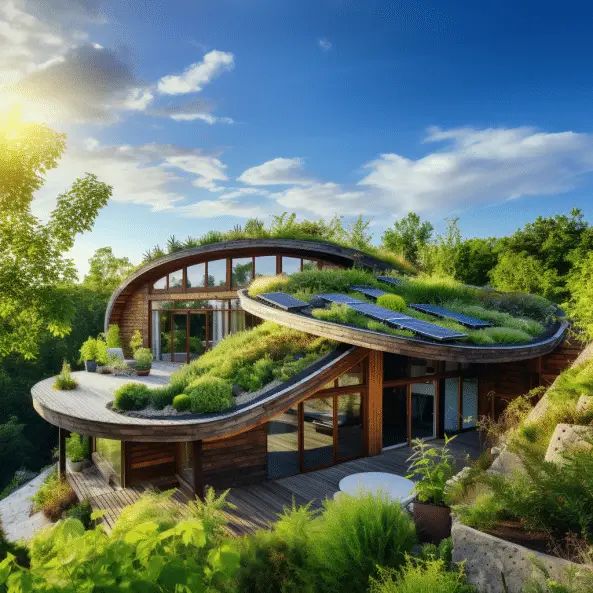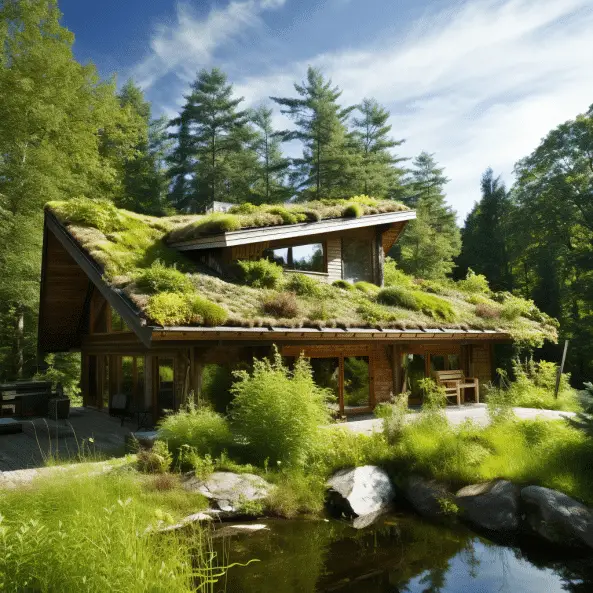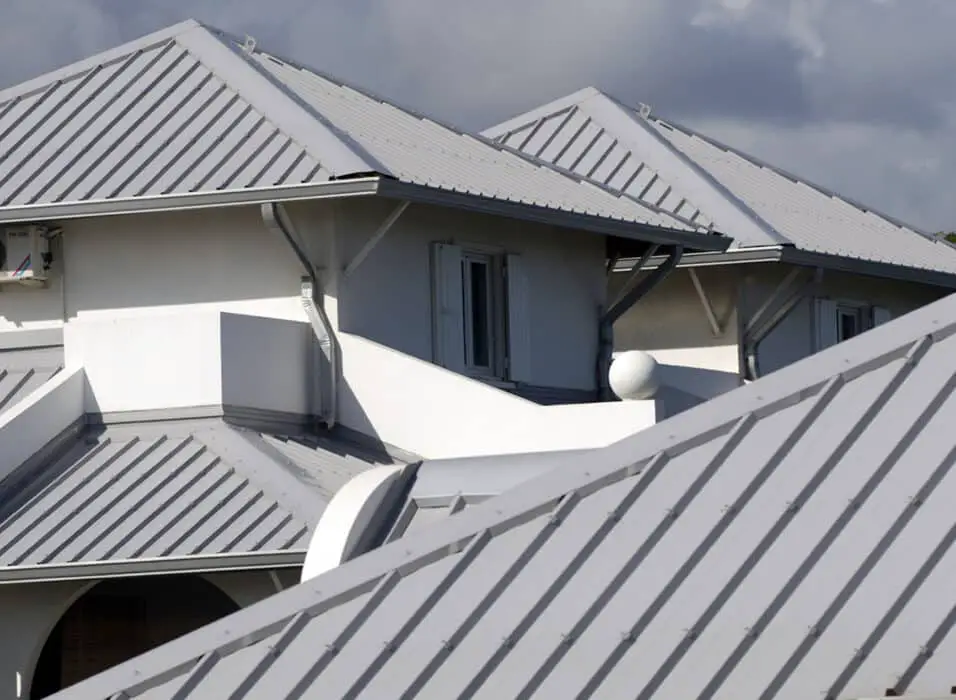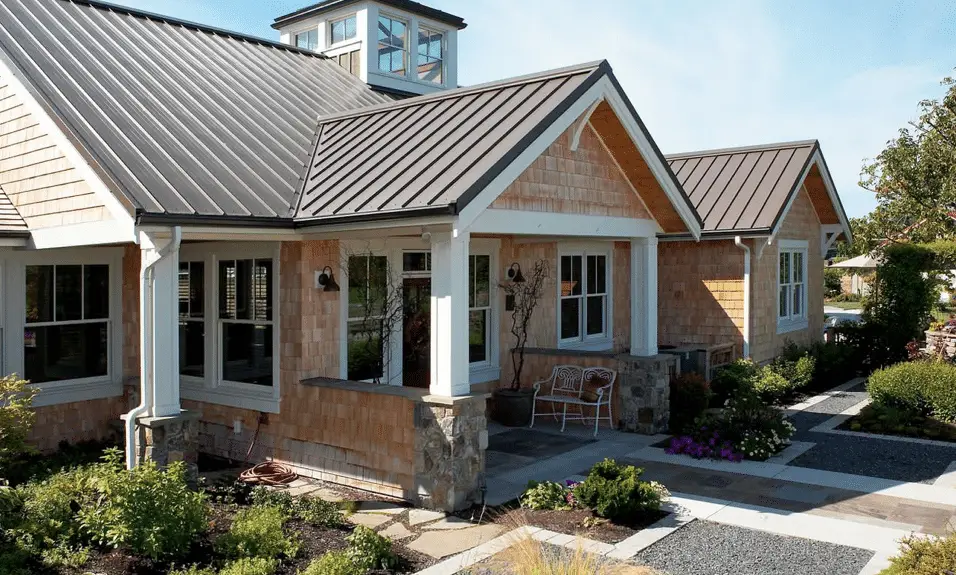Choosing Sustainable Roofing: A Guide to Eco-Friendly Homes
As the construction industry places a greater emphasis on sustainability, greener homes are becoming a popular choice for homeowners. One crucial aspect of creating an eco-friendly home is selecting the right roofing materials. With a range of options available, it’s essential to consider factors such as recycled content, environmental impact, durability, and warranty when choosing a sustainable roofing solution.
In this guide, I will explore the best environmentally friendly roofing materials, their benefits, and how they contribute to sustainable living. Whether you’re looking for green roofing options for a new build or considering an upgrade for your current roof, this guide will help you make an informed decision.
Key Takeaways:
- Environmentally friendly roofing materials are essential for creating greener homes.
- Factors such as recycled content, environmental impact, durability, and warranty should be considered when selecting a roofing material.
- There are various options available, including metal roofs, wood shakes, slate tiles, clay tiles, and composite shingles.
- Eco-friendly roofs are long-lasting, energy efficient, and contribute to sustainable living.
- Choosing reclaimed and recycled materials can further enhance the sustainability of roofing choices.
How to Choose the Right Eco-Friendly Roofing Material
Eco-friendly roofing materials require green production and products. The raw materials and production process determine roofing materials’ environmental impact. Consider these factors while choosing an eco-friendly roof:
- Recycled Roofing Materials: Utilize reclaimed roofing materials. The materials reduce waste and promote resource reuse. Products should list recycled content.
- Harmful Coatings: Be aware of roofing coatings. Chemicals in some coatings can affect the environment. Choose products with eco-friendly coatings or no toxins.
- Durability: Consider the durability of the roofing material. Longer-lasting materials reduce the need for frequent replacements, helping to reduce waste and conserve resources over time.
- Ability to Recycle: Look for roofing materials that can be recycled at the end of their lifespan. This ensures that the materials can be repurposed rather than ending up in landfills.
- Energy Star Certification: Consider roofing materials that carry the Energy Star certification. This certification indicates that the product meets strict energy efficiency standards, helping to reduce energy consumption and lower utility costs.
By taking these factors into account, you can choose an eco-friendly roofing material that aligns with your sustainability goals while still providing the necessary protection for your home.

Choosing eco-friendly roofing materials is not only beneficial for the environment but also for homeowners. These materials offer durability, energy efficiency, and attractive options for a greener home.
Table: Comparison of Eco-Friendly Roofing Materials
| Roofing Material | Recycled Content | Harmful Coatings | Durability | Ability to Recycle | Energy Star Certified |
|---|---|---|---|---|---|
| Metal Roofs | High | No | Long-lasting (100+ years) | Yes | Yes |
| Wood Shakes | Some | No | Durable (30 years) | No | No |
| Slate Tiles | No | No | Exceptionally long-lasting (75-200 years) | No | No |
| Clay Tiles | No | No | Durable (50+ years) | Yes | No |
| Composite Shingles | Varies | No | Long-lasting (up to 50 years) | Varies | No |
Each roofing material listed in the table offers different levels of eco-friendliness and varying characteristics. Consider your priorities and preferences when making a decision, and consult with roofing professionals to ensure you choose the right material for your home.
Metal Roofs
Metal roofs are an excellent choice for environmentally conscious homeowners. They offer a range of benefits, including energy efficiency, recyclability, and longevity. With their durability and attractive appearance, metal roofs have become a popular option for those looking for sustainable roofing materials.
One of the key advantages of metal roofs is their energy efficiency. They reflect heat from the sun, reducing the need for air conditioning and lowering energy consumption. This can lead to significant cost savings on utility bills while also minimizing the environmental impact.
Another important aspect of metal roofs is their recyclability. When it comes time to replace the roof, the metal materials can be recycled, reducing waste and supporting a circular economy. This makes metal roofs a sustainable choice that aligns with green living principles.
Benefits of Metal Roofs:
- Energy efficiency
- Recyclability
- Longevity
Additionally, metal roofs have an impressive longevity, often lasting for over 100 years with proper maintenance. This not only reduces the need for frequent roof replacements but also contributes to less waste in landfills. Metal roofs are built to withstand various weather conditions, making them a durable and reliable option for homeowners.
| Advantages of Metal Roofs | Disadvantages of Metal Roofs |
|---|---|
| Energy efficient | Higher initial cost |
| Recyclable | Noisier during heavy rain or hail |
| Long lifespan | Requires professional installation |
| Resistant to fire and extreme weather | May dent or scratch more easily than other materials |
“Metal roofs provide homeowners with an environmentally friendly option that combines energy efficiency, recyclability, and longevity. They are not only durable but also contribute to lower energy consumption and reduced waste. It’s a win-win for both homeowners and the planet.”
– Sustainable Roofing Solutions
Wood Shakes
Wood shakes are a popular choice for homeowners looking for an environmentally friendly roofing material that also adds a touch of classic elegance to their homes. Made from reclaimed wood, these shakes minimize the impact on the environment while providing durability and enhancing the curbside appeal of any property.
The use of reclaimed wood in the manufacturing process of wood shakes ensures that no new trees are cut down. Instead, the shakes are crafted from wood that has been salvaged, recycled, or sourced from sustainable forests. This sustainable approach makes wood shakes an excellent choice for those seeking eco-friendly roofing options.
When properly installed and maintained, wood shakes can last for around 30 years. Their natural resistance to extreme weather conditions and UV rays contributes to their longevity. Additionally, wood shakes offer excellent insulation properties, helping homeowners reduce their energy consumption and lower utility costs.
Benefits of Wood Shakes:
- Environmentally friendly option made from reclaimed wood
- Durable and resistant to extreme weather conditions
- Enhances the curbside appeal of a home
- Provides insulation, reducing energy consumption and costs
Overall, wood shakes are an attractive and sustainable roofing choice with their unique aesthetic appeal and durability. Their use of reclaimed wood and long lifespan make them an eco-friendly option for homeowners who want to make environmentally conscious decisions while maintaining the beauty of their homes.
| Wood Shakes | Benefits |
|---|---|
| Environmentally friendly | Made from reclaimed wood |
| Durable | Can last for around 30 years |
| Enhances curbside appeal | Provides a classic and elegant look |
| Energy efficient | Offers insulation properties |
Section 5: Slate Tiles
Slate tiles are a popular choice for homeowners seeking durability, exceptional longevity, fire resistance, and eco-friendly roofing materials. These stunning tiles can last between 75 to 200 years, making them a long-term investment for your home. While slate tiles may not be the most cost-effective option upfront, their longevity and minimal maintenance requirements make them a wise choice in the long run.
In addition to their exceptional longevity, slate tiles offer excellent fire resistance. This quality is especially important for homeowners looking to enhance their home’s safety measures. Slate tiles are naturally fire-resistant, providing an added layer of protection and peace of mind.
Furthermore, slate tiles are considered eco-friendly due to their sustainable nature. They are a natural product that does not involve the use of harmful chemicals or environmentally damaging manufacturing processes. By choosing slate tiles for your roof, you are making a conscious decision to reduce the ecological impact of your home.
Table: Comparison of Slate Tiles with Other Roofing Materials
| Roofing Material | Longevity | Fire Resistance | Eco-Friendly |
|---|---|---|---|
| Slate Tiles | 75-200 years | Excellent | Yes |
| Metal Roofs | 100+ years | Good | Yes |
| Wood Shakes | 30 years | Varies | Yes (if reclaimed wood) |
| Composite Shingles | Up to 50 years | Good | Yes (if made from recycled materials) |
| Clay Tiles | 50-100 years | Good | Yes |
As seen in the table above, slate tiles offer exceptional longevity, rivaling the durability of other eco-friendly roofing materials like metal roofs and clay tiles. They also excel in terms of fire resistance, providing an added layer of safety for your home. Additionally, slate tiles are an eco-friendly choice, contributing to a more sustainable living environment.
Clay Tiles: A Sustainable and Energy-Efficient Roofing Option
Clay tiles are an excellent choice for homeowners seeking energy-efficient and low-maintenance roofing materials. Not only do they offer a visually appealing aesthetic with a variety of colors and styles, but they also provide long-term durability and sustainability. Clay tiles are renowned for their ability to regulate temperature, keeping homes cooler in hot climates and reducing the need for excessive air conditioning.
Key Features of Clay Tiles
- Energy Efficiency: Clay tiles have inherent thermal properties that contribute to the energy efficiency of a building. Their natural composition helps to insulate the home, reducing the reliance on heating and cooling systems.
- Low Maintenance: Once clay tiles are installed, they require minimal maintenance. Their resistance to mold, rot, and pests means homeowners can enjoy peace of mind without the need for frequent repairs or replacements.
- Longevity: With proper installation and regular maintenance, clay tiles can last for several decades. Their long lifespan helps reduce waste and the environmental impact associated with frequent roof replacements.
- Sustainability: Clay tiles are made from natural materials, often sourced from local clay deposits. Their production process typically involves minimal energy consumption, making them a sustainable choice for environmentally conscious homeowners.
“Clay tiles offer both beauty and sustainability, providing homeowners with a long-lasting roofing option that requires little maintenance. Their energy-efficient properties contribute to a greener home and reduce utility costs.” – Roofing expert
While clay tiles offer numerous benefits, it’s important to consider the structural requirements before installation. Due to their weight and fragility, clay tiles require a strong and sturdy roofing infrastructure to support their load. Additionally, professional installation is recommended to ensure the tiles are properly aligned and securely fastened.
| Advantages of Clay Tiles | Considerations |
|---|---|
|
|
Composite Shingles
Composite shingles are an excellent choice for homeowners looking for sustainable roofing options. These shingles are made from a combination of synthetic polymers, recycled materials, and natural substances like slate and wood. The result is an attractive roofing material that emulates the appearance of traditional materials while offering enhanced durability and longevity.
One of the key advantages of composite shingles is their sustainable foundation. By incorporating recycled materials into their production, these shingles help reduce waste and promote a circular economy. Additionally, the use of synthetic polymers and other durable components ensures that composite shingles have a longer lifespan compared to traditional roofing materials, reducing the need for replacements and minimizing the environmental impact.
Not only are composite shingles environmentally friendly, but they also come in a variety of attractive styles. Whether you prefer the look of slate, clay, or wood shakes, composite shingles can mimic the appearance of these materials, allowing you to achieve the aesthetic you desire for your home. With a wide range of colors and finishes available, you can find the perfect composite shingles to complement your house’s architectural style.
Composite Shingles at a Glance
| Benefits | Considerations |
|---|---|
| Highly durable and long-lasting | Costlier than some traditional options |
| Environmentally friendly and sustainable | Professional installation may be required |
| Wide variety of styles and colors | Regular maintenance is necessary |
Composite shingles offer homeowners a sustainable roofing option with long-lasting performance and attractive styles.
When considering eco-friendly roofing materials, composite shingles should certainly be on your list of options. With their sustainable foundation, durability, and aesthetic versatility, they provide an excellent choice for those looking to make their homes more environmentally conscious. By investing in composite shingles, you can enjoy a long-lasting and attractive roof while contributing to a greener future.
The Benefits of Eco-Friendly Roofing
Eco-friendly roofing materials offer numerous benefits for homeowners. Not only are they environmentally conscious choices, but they also provide long-lasting durability, energy efficiency, and attractive aesthetics.
Long-Lasting
Eco-friendly roofs tend to have a longer lifespan compared to conventional roofing options. For example, metal roofs can last over 100 years with proper maintenance, while slate tiles can last from 75 to 200 years. This means that homeowners won’t have to worry about frequent replacements, saving them time, money, and resources in the long run.
Energy Efficient
Another advantage of eco-friendly roofing is its energy efficiency. Many sustainable roofing materials are designed to reflect heat, keeping homes cooler during hot summers. This can lead to reduced energy consumption for cooling purposes, resulting in lower utility bills. In addition, some eco-friendly options, such as green roofs or cool roofs, provide natural insulation, further enhancing energy efficiency.
Attractive
Eco-friendly roofs are not only good for the environment and energy savings, but they also enhance the aesthetic appeal of a home. With a wide range of materials, styles, and colors available, homeowners can choose a roofing option that complements their architectural design and personal preferences. Whether it’s the rustic charm of wood shakes or the timeless elegance of slate tiles, eco-friendly roofing materials can elevate the look of any home.
In summary, eco-friendly roofing offers homeowners the opportunity to make sustainable choices while enjoying the benefits of long-lasting durability, energy efficiency, and attractive aesthetics. By opting for environmentally conscious materials, homeowners can contribute to a greener future and create a more sustainable living environment for themselves and future generations.
Table: Comparison of Eco-Friendly Roofing Materials
| Roofing Material | Longevity | Energy Efficiency | Aesthetics |
|---|---|---|---|
| Metal Roofs | Over 100 years | Highly energy efficient | Sleek and modern |
| Wood Shakes | Around 30 years | Natural insulation | Classic and charming |
| Slate Tiles | 75 to 200 years | Excellent heat reflection | Timeless and elegant |
| Clay Tiles | 50 to 100 years | Great insulation properties | Variety of colors and styles |
| Composite Shingles | Up to 50 years | Numerous design options | Emulates natural materials |
Note: The table provides a general overview and may vary based on specific manufacturers and installation practices. Consult with roofing professionals for the most accurate information regarding each material’s performance.

Conclusion
In conclusion, eco-friendly roofing materials provide homeowners with sustainable choices that promote greener homes. By opting for environmentally friendly roof designs, individuals can contribute to renewable energy efforts while enjoying the benefits of durability and energy efficiency.
From cool roofs and green roofs to metal, wood, slate, and composite shingles, there are various options available to suit different preferences and budgets. These sustainable materials offer a longer lifespan compared to conventional roofing options, reducing the need for frequent replacements.
Furthermore, eco-friendly roofs are energy efficient, helping to lower utility costs and create a more sustainable living environment. Not only do they contribute to a more eco-friendly future, but they also enhance the aesthetic appeal of a home.
Emphasizing the use of reclaimed and recycled materials can further enhance the sustainability of roofing choices. By considering these factors, homeowners can make informed decisions that align with their environmental values and contribute to a greener tomorrow.
FAQ
What should I consider when choosing an eco-friendly roofing material?
Factors to consider include recycled content, harmful coatings, durability, ability to recycle, and Energy Star certification.
How long can metal roofs last?
With proper maintenance, metal roofs can last for over 100 years.
Are wood shakes environmentally friendly?
Many wood shakes today are made from reclaimed wood, minimizing the impact on the environment.
How long can slate tiles last?
Slate tiles can last from 75 to 200 years, making them one of the most durable options.
Are clay tiles energy efficient?
Yes, clay tiles are energy efficient and relatively low maintenance.
What are composite shingles made of?
Composite shingles are made from a blend of synthetic polymers, slate, laminate, wood, and recycled materials.
How can eco-friendly roofing materials benefit homeowners?
Eco-friendly roofing materials tend to last longer, reduce the need for frequent replacements, lower utility costs, and enhance the aesthetic appeal of a home.
What options are available for environmentally friendly roofing materials?
Options include cool roofs, green roofs, metal roofs, wood shakes, slate tiles, clay tiles, and composite shingles.
How can choosing sustainable roofing materials contribute to a greener future?
By choosing sustainable materials, homeowners can contribute to reducing environmental impact and promoting sustainable living.
What are some ways to enhance the sustainability of roofing choices?
Consideration of reclaimed and recycled materials can further enhance the sustainability of the roofing choices.








